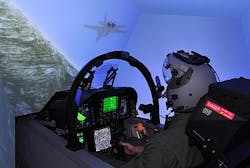L-3 to upgrade flight simulators for Navy and Marine Corps jets with high-definition imagery
ORLANDO, Fla., 10 July 2013.Simulation and training experts at the L-3 Communications Link Simulation & Training segment in Arlington, Texas, are making plans to upgrade tactical operational flight trainers for U.S. Navy and Marine Corps F/A-18 combat jet pilots with high-definition (HD) imagery.
Officials of the Naval Air Warfare Center Training Systems Division in Orlando, Fla., announced a $33.2 million contract modification this week to L-3 Link Simulation & Training to provide tactical operational flight trainer (TOFT) HD imagery kits to upgrade the Navy and Marine Corps combat jet flight simulators.
The HD imagery upgrades will be for F/A-18 simulators at Oceana Naval Air Station, Va.; Lemoore Naval Air Station, Calif.; Whidbey Island Naval Air Station, Wash.; and Miramar Marine Corps Air Station, Calif.
The L-3 Link Simulation & Training flight simulators support Navy and Marine Corps F/A-18C/D Hornet strike fighters, F/A-18E/F Super Hornet fighter-bombers, and EA-18G Growler electronic warfare jets.
The F/A-18 TOFT simulators help train pilots in field and carrier takeoffs and landings, low-altitude flight, air-to-air and air-to-ground weapons delivery, electronic countermeasures and emergency procedures.
As pilots develop and refine their air-to-air combat skills on the trainer, the simulator can vary the offensive and defensive skill level of the adversaries.
The simulators also can extend combat training realism for Hornet and Super Hornet pilots by networking F/A-18 TOFTs together to enable several aircrews to conduct tactical combat training against common, simulated threats, L-3 officials say.
These simulators feature the L-3 SimuSphere dodecahedron-shaped visual display system that provides equally high visual scene brightness and resolution across all of its same-sized pentagonal panels. The simulators also have L-3 Link's SimuView personal computer image generation system, which provides out-the-window and sensor imagery.
The HD visual system kits that L-3 will provide will upgrade these simulators with SimuSphere HD to improve the visual acuity of the simulators to enable pilots to detect and identify targets from distances they experience during actual missions, L-3 officials say.
SimuSphere HD will display out-the-window imagery at unprecedented levels of resolution, brightness, and contrast, and will immerse pilots in a virtual training environment equivalent to real-world missions, far exceeding the ability of currently fielded simulators visual display capabilities, company officials say.
SimuSphere HD can provide either a 180- or 360-degree field-of-view, and can display out-the-window imagery at 20/40 visual acuity. As digital liquid crystal on silicon (LCoS) projection technology advances, L-3 will enhance SimuSphere HD to provide 20/20 resolution, officials say.
In support of night vision training requirements, SimuSphere HD also provides a realistic stimulated night-vision goggle mission capability. Pilots attach their own night-vision goggles to their helmets, steps into cockpits surrounded by SimuSphere HD, and experience realistic halos, light blooms, and other night-vision effects they would encounter during a night mission.
On the current contract modification, L-3 experts will provide 12 TOFT HD visual system kits at Oceana, Lemoore, and Whidbey Island; HD projectors and mirrors for the six TOFTs at Miramar; four TOFT HD visual systems at Whidbey Island; as well as uninterrupted power sources for four TOFTs to support the HD visual systems at Oceana. The contract also includes spare parts.
The order also is for HD visual systems for two Australian F/A-18E/F Super Hornets TOFTs for the Royal Australian Air Force. L-3 will do the work in Arlington, Texas ; Oak Harbor, Wash.; Virginia Beach, Va.; Lemoore, Calif.; Royal Australian Air Force Base Amberley, Australia; Miramar, Calif.; and Atsugi, Japan; and should be finished in May 2016.
For more information contact L-3 Link Simulation & Training online at www.link.com, or the Naval Air Warfare Center Training Systems Division at www.navair.navy.mil/nawctsd.
